Tourism Environment and Industry: Sustainable Development in Japan
VerifiedAdded on 2023/06/07
|9
|2681
|311
Essay
AI Summary
This essay explores the tourism environment and industry in Japan, focusing on sustainable development. It discusses the principles of sustainable tourism, the roles of stakeholders in decision-making, and the analysis of macro and micro environmental factors influencing the demand in the tourism industry. The essay highlights Japan's efforts in promoting ecotourism, sustainable transportation, and eco-friendly practices. It also emphasizes the importance of political, economic, social, technological, legal, and environmental factors in achieving sustainable tourism. The roles of tourists, government, businesses, and local residents are crucial for the sustainable development. Furthermore, the essay analyzes competitive micro-environment factors and tourist motivating factors that influence demand, such as physical relaxation, interpersonal motivation, and social status. The recommendation emphasizes maintaining sustainability across environmental, social, and economic pillars to attract more tourists.
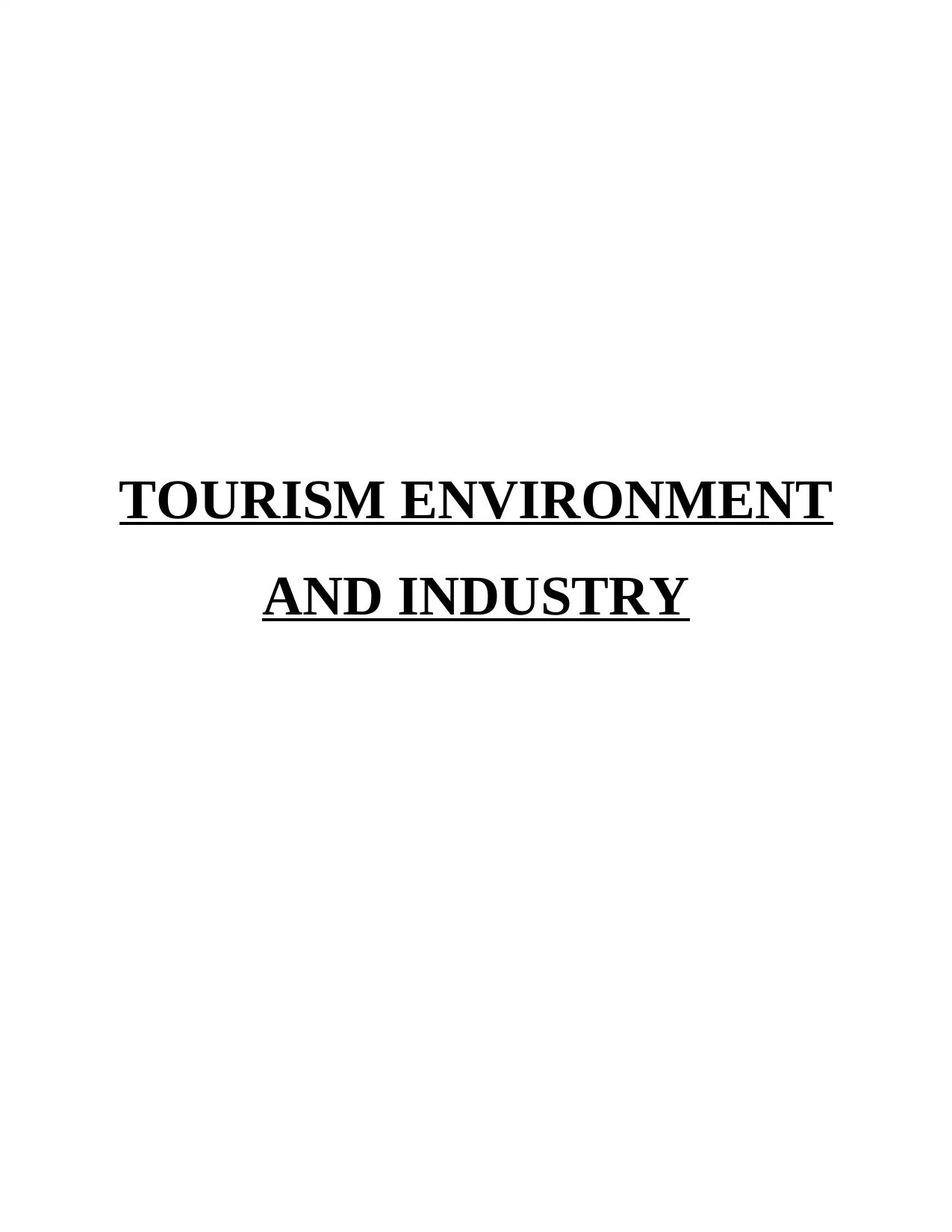
TOURISM ENVIRONMENT
AND INDUSTRY
AND INDUSTRY
Paraphrase This Document
Need a fresh take? Get an instant paraphrase of this document with our AI Paraphraser
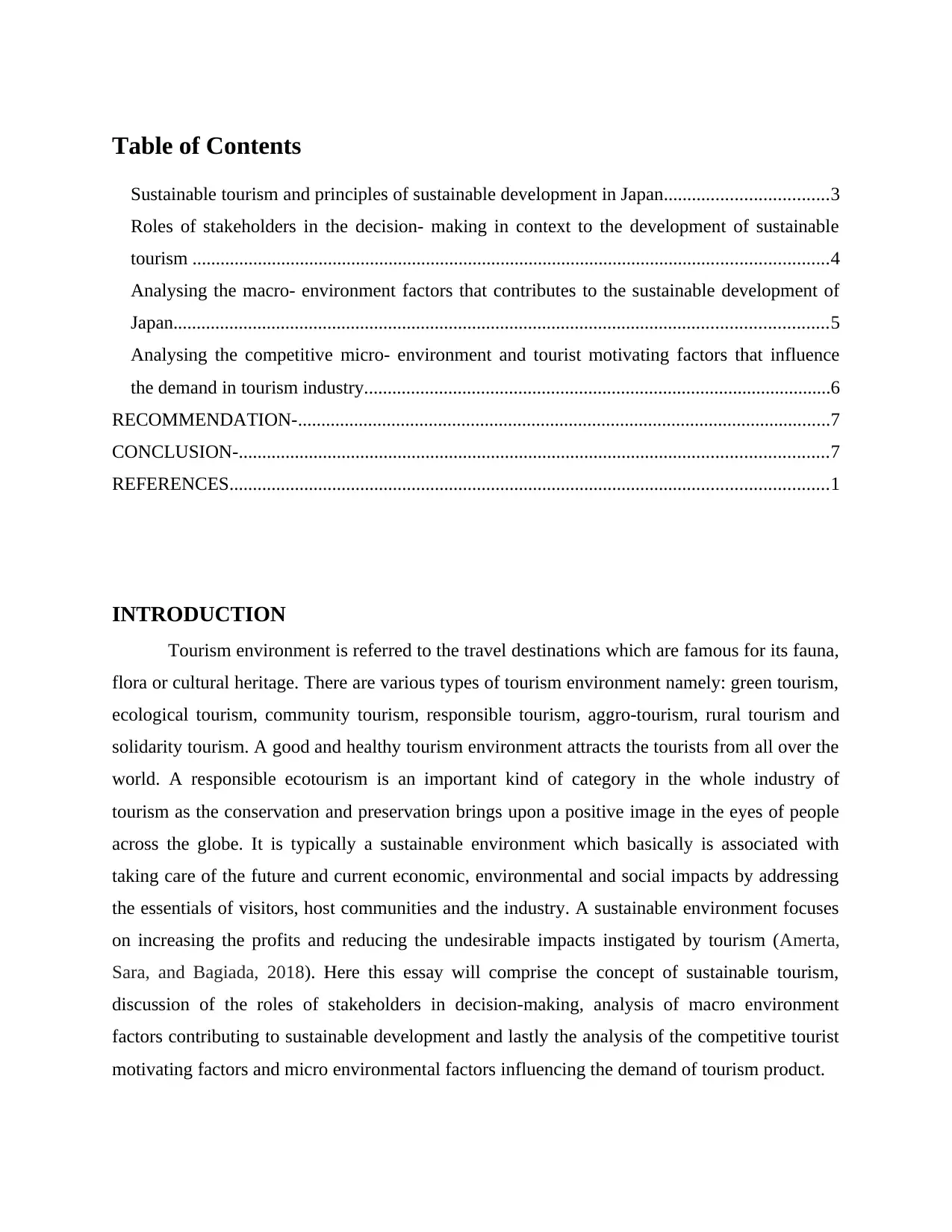
Table of Contents
Sustainable tourism and principles of sustainable development in Japan...................................3
Roles of stakeholders in the decision- making in context to the development of sustainable
tourism ........................................................................................................................................4
Analysing the macro- environment factors that contributes to the sustainable development of
Japan............................................................................................................................................5
Analysing the competitive micro- environment and tourist motivating factors that influence
the demand in tourism industry....................................................................................................6
RECOMMENDATION-..................................................................................................................7
CONCLUSION-..............................................................................................................................7
REFERENCES................................................................................................................................1
INTRODUCTION
Tourism environment is referred to the travel destinations which are famous for its fauna,
flora or cultural heritage. There are various types of tourism environment namely: green tourism,
ecological tourism, community tourism, responsible tourism, aggro-tourism, rural tourism and
solidarity tourism. A good and healthy tourism environment attracts the tourists from all over the
world. A responsible ecotourism is an important kind of category in the whole industry of
tourism as the conservation and preservation brings upon a positive image in the eyes of people
across the globe. It is typically a sustainable environment which basically is associated with
taking care of the future and current economic, environmental and social impacts by addressing
the essentials of visitors, host communities and the industry. A sustainable environment focuses
on increasing the profits and reducing the undesirable impacts instigated by tourism (Amerta,
Sara, and Bagiada, 2018). Here this essay will comprise the concept of sustainable tourism,
discussion of the roles of stakeholders in decision-making, analysis of macro environment
factors contributing to sustainable development and lastly the analysis of the competitive tourist
motivating factors and micro environmental factors influencing the demand of tourism product.
Sustainable tourism and principles of sustainable development in Japan...................................3
Roles of stakeholders in the decision- making in context to the development of sustainable
tourism ........................................................................................................................................4
Analysing the macro- environment factors that contributes to the sustainable development of
Japan............................................................................................................................................5
Analysing the competitive micro- environment and tourist motivating factors that influence
the demand in tourism industry....................................................................................................6
RECOMMENDATION-..................................................................................................................7
CONCLUSION-..............................................................................................................................7
REFERENCES................................................................................................................................1
INTRODUCTION
Tourism environment is referred to the travel destinations which are famous for its fauna,
flora or cultural heritage. There are various types of tourism environment namely: green tourism,
ecological tourism, community tourism, responsible tourism, aggro-tourism, rural tourism and
solidarity tourism. A good and healthy tourism environment attracts the tourists from all over the
world. A responsible ecotourism is an important kind of category in the whole industry of
tourism as the conservation and preservation brings upon a positive image in the eyes of people
across the globe. It is typically a sustainable environment which basically is associated with
taking care of the future and current economic, environmental and social impacts by addressing
the essentials of visitors, host communities and the industry. A sustainable environment focuses
on increasing the profits and reducing the undesirable impacts instigated by tourism (Amerta,
Sara, and Bagiada, 2018). Here this essay will comprise the concept of sustainable tourism,
discussion of the roles of stakeholders in decision-making, analysis of macro environment
factors contributing to sustainable development and lastly the analysis of the competitive tourist
motivating factors and micro environmental factors influencing the demand of tourism product.

MAIN BODY
Sustainable tourism and principles of sustainable development in Japan
Sustainable tourism is associated with the concept of taking into account sustainable practices by
the whole industry of tourism. It is the acknowledgement of both negative and positive factors of
tourism. The main purpose of sustainable tourism is to reduce the negative effects and increase
the positive effects. By negative effects it means harm to the nature, overcrowding and economic
leakage whereas, positive effects comprise preservation of cultural heritage, preservation of
wildlife, job creation etc. The world is moving towards sustainability and the population is also
likely to move to the places which are practising the use of suitable approaches towards
everything.
Japan, an island country in the East Asia, is situated to the Northway of Pacific Ocean and is
bordered by the Sea of Japan from the west. The country shares a part of Ring fire and is also the
most popular country as it comes to the 11th number position in the world. Japan’s economy is
also a second largest in the world as it observed an economic miracle growth after the World
War 2. Although its facing a huge declination in the population, it has the highest rate of life
expectancy. The country is doing a wonderful job by giving its best in almost everything. The
country is also the global leader in robotics, electronic industries and automotive which makes a
lot of tourist to come and visit a complete advanced country.
The country is doing everything that is possible to break the records of every time in the tourism
industry but it is also equally important for the country to maintain its sustainability. Here are
some examples of the principles for maintaining a sustainable tourism environment: Promoting
the Japanese Ecotourism which means attracting the tourists towards the activities which are no
harm to the environments such as the hiking, mountain climbing, scuba diving, river rafting,
visiting temple, visiting shrines and hot springs etc. Japan has beautiful temple spots which
attracts large number of tourists (Hinch, and Ito, 2018). Another way in which the country can
maintain a sustainable environment is by making the travelling part sustainable for example
using the bicycles, trains and buses rather than the taxis, domestic flights and cars. The country
can this way save the fuel for the future purposes and also reduce the pollution which has
Sustainable tourism and principles of sustainable development in Japan
Sustainable tourism is associated with the concept of taking into account sustainable practices by
the whole industry of tourism. It is the acknowledgement of both negative and positive factors of
tourism. The main purpose of sustainable tourism is to reduce the negative effects and increase
the positive effects. By negative effects it means harm to the nature, overcrowding and economic
leakage whereas, positive effects comprise preservation of cultural heritage, preservation of
wildlife, job creation etc. The world is moving towards sustainability and the population is also
likely to move to the places which are practising the use of suitable approaches towards
everything.
Japan, an island country in the East Asia, is situated to the Northway of Pacific Ocean and is
bordered by the Sea of Japan from the west. The country shares a part of Ring fire and is also the
most popular country as it comes to the 11th number position in the world. Japan’s economy is
also a second largest in the world as it observed an economic miracle growth after the World
War 2. Although its facing a huge declination in the population, it has the highest rate of life
expectancy. The country is doing a wonderful job by giving its best in almost everything. The
country is also the global leader in robotics, electronic industries and automotive which makes a
lot of tourist to come and visit a complete advanced country.
The country is doing everything that is possible to break the records of every time in the tourism
industry but it is also equally important for the country to maintain its sustainability. Here are
some examples of the principles for maintaining a sustainable tourism environment: Promoting
the Japanese Ecotourism which means attracting the tourists towards the activities which are no
harm to the environments such as the hiking, mountain climbing, scuba diving, river rafting,
visiting temple, visiting shrines and hot springs etc. Japan has beautiful temple spots which
attracts large number of tourists (Hinch, and Ito, 2018). Another way in which the country can
maintain a sustainable environment is by making the travelling part sustainable for example
using the bicycles, trains and buses rather than the taxis, domestic flights and cars. The country
can this way save the fuel for the future purposes and also reduce the pollution which has
⊘ This is a preview!⊘
Do you want full access?
Subscribe today to unlock all pages.

Trusted by 1+ million students worldwide
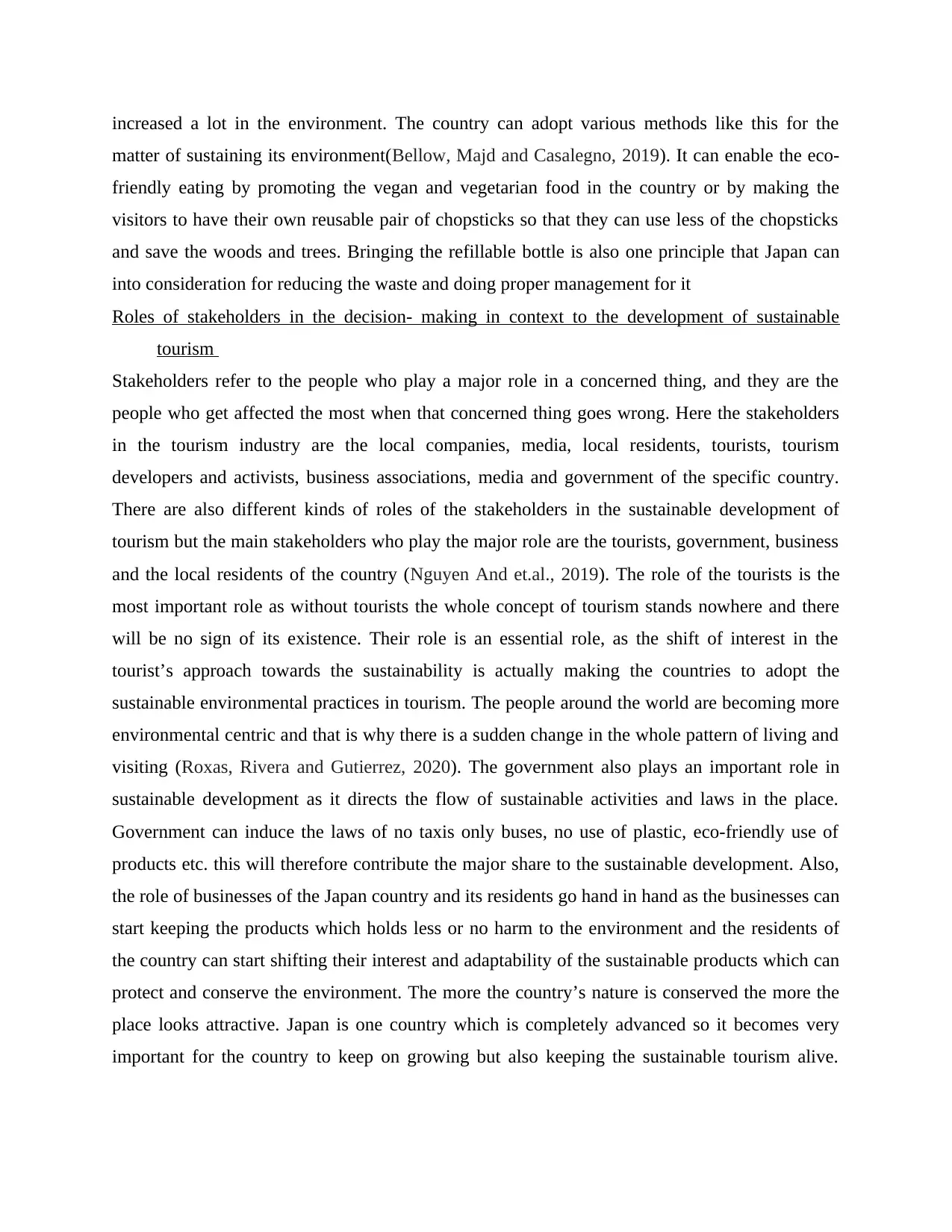
increased a lot in the environment. The country can adopt various methods like this for the
matter of sustaining its environment(Bellow, Majd and Casalegno, 2019). It can enable the eco-
friendly eating by promoting the vegan and vegetarian food in the country or by making the
visitors to have their own reusable pair of chopsticks so that they can use less of the chopsticks
and save the woods and trees. Bringing the refillable bottle is also one principle that Japan can
into consideration for reducing the waste and doing proper management for it
Roles of stakeholders in the decision- making in context to the development of sustainable
tourism
Stakeholders refer to the people who play a major role in a concerned thing, and they are the
people who get affected the most when that concerned thing goes wrong. Here the stakeholders
in the tourism industry are the local companies, media, local residents, tourists, tourism
developers and activists, business associations, media and government of the specific country.
There are also different kinds of roles of the stakeholders in the sustainable development of
tourism but the main stakeholders who play the major role are the tourists, government, business
and the local residents of the country (Nguyen And et.al., 2019). The role of the tourists is the
most important role as without tourists the whole concept of tourism stands nowhere and there
will be no sign of its existence. Their role is an essential role, as the shift of interest in the
tourist’s approach towards the sustainability is actually making the countries to adopt the
sustainable environmental practices in tourism. The people around the world are becoming more
environmental centric and that is why there is a sudden change in the whole pattern of living and
visiting (Roxas, Rivera and Gutierrez, 2020). The government also plays an important role in
sustainable development as it directs the flow of sustainable activities and laws in the place.
Government can induce the laws of no taxis only buses, no use of plastic, eco-friendly use of
products etc. this will therefore contribute the major share to the sustainable development. Also,
the role of businesses of the Japan country and its residents go hand in hand as the businesses can
start keeping the products which holds less or no harm to the environment and the residents of
the country can start shifting their interest and adaptability of the sustainable products which can
protect and conserve the environment. The more the country’s nature is conserved the more the
place looks attractive. Japan is one country which is completely advanced so it becomes very
important for the country to keep on growing but also keeping the sustainable tourism alive.
matter of sustaining its environment(Bellow, Majd and Casalegno, 2019). It can enable the eco-
friendly eating by promoting the vegan and vegetarian food in the country or by making the
visitors to have their own reusable pair of chopsticks so that they can use less of the chopsticks
and save the woods and trees. Bringing the refillable bottle is also one principle that Japan can
into consideration for reducing the waste and doing proper management for it
Roles of stakeholders in the decision- making in context to the development of sustainable
tourism
Stakeholders refer to the people who play a major role in a concerned thing, and they are the
people who get affected the most when that concerned thing goes wrong. Here the stakeholders
in the tourism industry are the local companies, media, local residents, tourists, tourism
developers and activists, business associations, media and government of the specific country.
There are also different kinds of roles of the stakeholders in the sustainable development of
tourism but the main stakeholders who play the major role are the tourists, government, business
and the local residents of the country (Nguyen And et.al., 2019). The role of the tourists is the
most important role as without tourists the whole concept of tourism stands nowhere and there
will be no sign of its existence. Their role is an essential role, as the shift of interest in the
tourist’s approach towards the sustainability is actually making the countries to adopt the
sustainable environmental practices in tourism. The people around the world are becoming more
environmental centric and that is why there is a sudden change in the whole pattern of living and
visiting (Roxas, Rivera and Gutierrez, 2020). The government also plays an important role in
sustainable development as it directs the flow of sustainable activities and laws in the place.
Government can induce the laws of no taxis only buses, no use of plastic, eco-friendly use of
products etc. this will therefore contribute the major share to the sustainable development. Also,
the role of businesses of the Japan country and its residents go hand in hand as the businesses can
start keeping the products which holds less or no harm to the environment and the residents of
the country can start shifting their interest and adaptability of the sustainable products which can
protect and conserve the environment. The more the country’s nature is conserved the more the
place looks attractive. Japan is one country which is completely advanced so it becomes very
important for the country to keep on growing but also keeping the sustainable tourism alive.
Paraphrase This Document
Need a fresh take? Get an instant paraphrase of this document with our AI Paraphraser

Therefore, the main role of government, businesses, residents and tourists plays a major role
behind the sustainable development.
Analysing the macro- environment factors that contributes to the sustainable development of
Japan.
The various factors that contributes to the growth of the sustainable development in the country
japan are as follows-
The political factors all those factors that are related with the political environment of the
particular country. Better the political environment of the country, the more will consumer get
attracted towards the particular place. Japan country has laws and regulations that are stable in
nature and the open boarder movement has contributed to the development of the sustainable
tourism. The easy accessibility of the visa has also done lot in attracting visitors from various
places.
The Economic factors of the country also helps the country in enhancing country as a
tourism industry because stable economic increases the purchasing power of the particular
country. The technology is another factor related with the economy of the country. Japan has
been far in technology than most of the countries today and that has enabled the country to
attract tourist from all over the world (Cai, and et.al.,2020).
Social factors are all related with the lifestyle of the people. It also involves the
democracy factor in it. Japan being a democratic country has never ignored the freedom of
people in the country. Social factors plays major role because no traveller likes to visit the place
where government does not offer freedom and safety to its people (Kožić, Sorić, and Sever,
2021). Cultural harmony and trends on social media platforms also induces people to visit
particular place.
Technological factors are those factors that are related with the technology of the
particular country like the affordable transportation system. Japan is the country benefited
because of its advancement in the technological industry. Improved communication network,
proper guest service systems has attracted people from all over the world. This factor the reason
behind replacing expensive human labour with the technological factors that in turn reduces all
the labour cost and provide best services to the consumers.
Legal factors is also one of the macro economy factors in tourism industry that too
includes all the government laws, rules- regulation related and the strategies adopted by the
behind the sustainable development.
Analysing the macro- environment factors that contributes to the sustainable development of
Japan.
The various factors that contributes to the growth of the sustainable development in the country
japan are as follows-
The political factors all those factors that are related with the political environment of the
particular country. Better the political environment of the country, the more will consumer get
attracted towards the particular place. Japan country has laws and regulations that are stable in
nature and the open boarder movement has contributed to the development of the sustainable
tourism. The easy accessibility of the visa has also done lot in attracting visitors from various
places.
The Economic factors of the country also helps the country in enhancing country as a
tourism industry because stable economic increases the purchasing power of the particular
country. The technology is another factor related with the economy of the country. Japan has
been far in technology than most of the countries today and that has enabled the country to
attract tourist from all over the world (Cai, and et.al.,2020).
Social factors are all related with the lifestyle of the people. It also involves the
democracy factor in it. Japan being a democratic country has never ignored the freedom of
people in the country. Social factors plays major role because no traveller likes to visit the place
where government does not offer freedom and safety to its people (Kožić, Sorić, and Sever,
2021). Cultural harmony and trends on social media platforms also induces people to visit
particular place.
Technological factors are those factors that are related with the technology of the
particular country like the affordable transportation system. Japan is the country benefited
because of its advancement in the technological industry. Improved communication network,
proper guest service systems has attracted people from all over the world. This factor the reason
behind replacing expensive human labour with the technological factors that in turn reduces all
the labour cost and provide best services to the consumers.
Legal factors is also one of the macro economy factors in tourism industry that too
includes all the government laws, rules- regulation related and the strategies adopted by the

country to boost the business system of the economy. Better laws provides security to the
visitors. The Visitors only visit is the place that are safe for them like all the health laws,
consumer protection laws and the environmental laws etc. Japan has one of the best legal laws
and that has always been the plus point in tourism industry (Gozgor, and et.al., 2019).
Environmental factors- All the environmental factors has become the most important factor for
the country today. The raising environmental factors is becoming concern for the countries
today. Japan has been able to make such laws and rules- regulation that help not only japan but
whole world to tackle climate changes issues. Reducing pollution is one of that thing that has
attracted tourist for the Japan from worldwide (Pan, Y., and et.al., 2021).
Analysing the competitive micro- environment and tourist motivating factors that influence the
demand in tourism industry.
There are various Competitive micro-environment factors that induces one to travel to the
particular destination. The countries should y to understand all the travel motives that related to
the individual. The physical relaxation is the primer motive of one while travelling, Japan has
been able to advertise its country as a tourist destination spot that helps the travellers to free
themselves from the daily life routine. Japan government in trying its best to create the desire in
the mind of the people to visit Japan at once. Various social media platforms has enabled country
to create more awareness about the country and the different cultures that Japan belongs too.
Generally travellers visit new places to meet new people and the different cultures they belong
too. This type of motivation comes as interpersonal motivation. This is the desire that comes
from within to try something new and get experience of the different things.
Many individual today are also affected and motivated in order to increase their status
and prestige in the society. This is done by posting pictures from various social media platforms.
Today, many individuals feel that status and prestige of one is needed to create the perception of
the individual and its done through social media platforms like the WhatsApp, Facebook and the
Instagram. For creating individual perception individual has started travelling lot and visit
different places they can.
These were general factors that induces one to travel the particular destination and this all factors
have been kept in mind by the Japan government that in turn has enabled the country to earn
more by creating the sustainable development in tourism industry.
visitors. The Visitors only visit is the place that are safe for them like all the health laws,
consumer protection laws and the environmental laws etc. Japan has one of the best legal laws
and that has always been the plus point in tourism industry (Gozgor, and et.al., 2019).
Environmental factors- All the environmental factors has become the most important factor for
the country today. The raising environmental factors is becoming concern for the countries
today. Japan has been able to make such laws and rules- regulation that help not only japan but
whole world to tackle climate changes issues. Reducing pollution is one of that thing that has
attracted tourist for the Japan from worldwide (Pan, Y., and et.al., 2021).
Analysing the competitive micro- environment and tourist motivating factors that influence the
demand in tourism industry.
There are various Competitive micro-environment factors that induces one to travel to the
particular destination. The countries should y to understand all the travel motives that related to
the individual. The physical relaxation is the primer motive of one while travelling, Japan has
been able to advertise its country as a tourist destination spot that helps the travellers to free
themselves from the daily life routine. Japan government in trying its best to create the desire in
the mind of the people to visit Japan at once. Various social media platforms has enabled country
to create more awareness about the country and the different cultures that Japan belongs too.
Generally travellers visit new places to meet new people and the different cultures they belong
too. This type of motivation comes as interpersonal motivation. This is the desire that comes
from within to try something new and get experience of the different things.
Many individual today are also affected and motivated in order to increase their status
and prestige in the society. This is done by posting pictures from various social media platforms.
Today, many individuals feel that status and prestige of one is needed to create the perception of
the individual and its done through social media platforms like the WhatsApp, Facebook and the
Instagram. For creating individual perception individual has started travelling lot and visit
different places they can.
These were general factors that induces one to travel the particular destination and this all factors
have been kept in mind by the Japan government that in turn has enabled the country to earn
more by creating the sustainable development in tourism industry.
⊘ This is a preview!⊘
Do you want full access?
Subscribe today to unlock all pages.

Trusted by 1+ million students worldwide
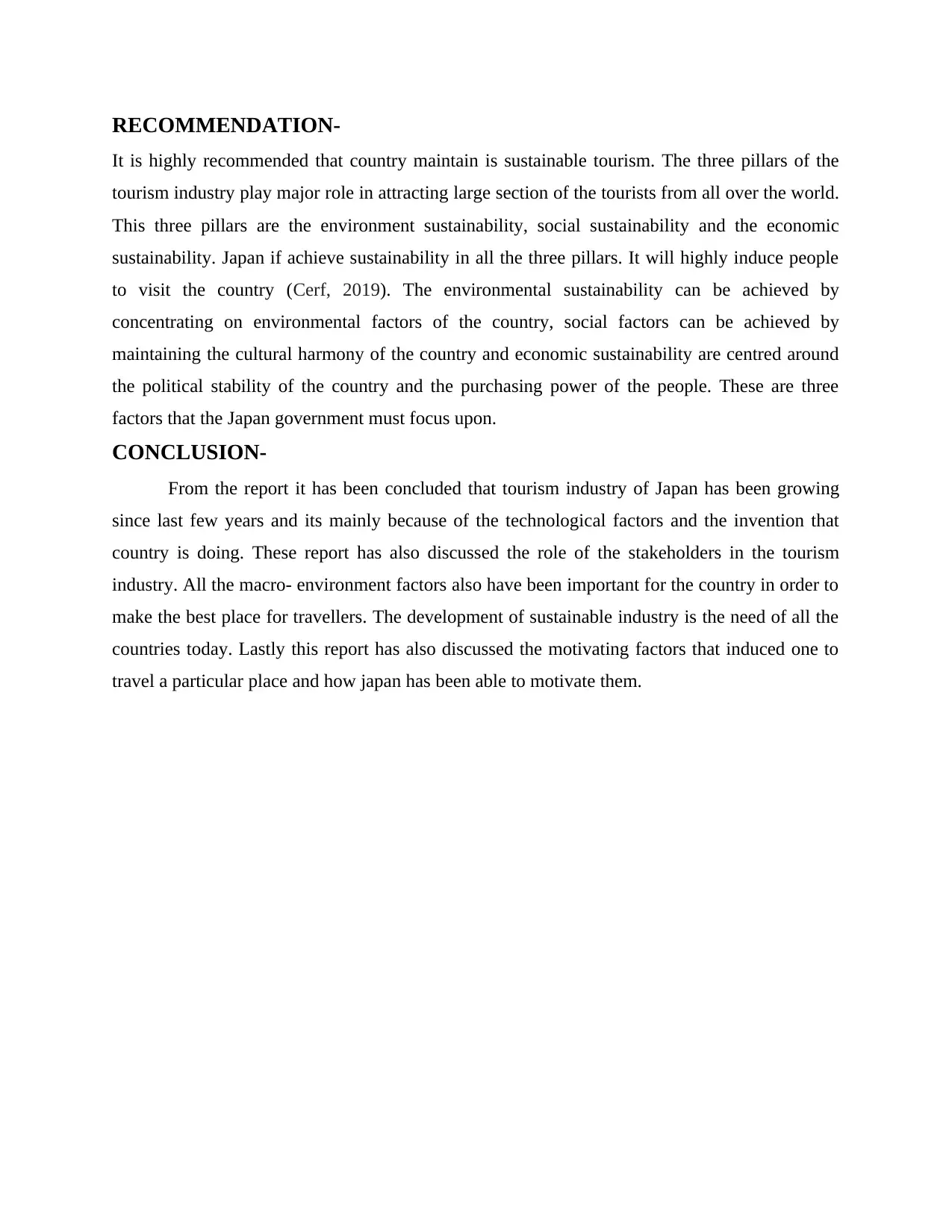
RECOMMENDATION-
It is highly recommended that country maintain is sustainable tourism. The three pillars of the
tourism industry play major role in attracting large section of the tourists from all over the world.
This three pillars are the environment sustainability, social sustainability and the economic
sustainability. Japan if achieve sustainability in all the three pillars. It will highly induce people
to visit the country (Cerf, 2019). The environmental sustainability can be achieved by
concentrating on environmental factors of the country, social factors can be achieved by
maintaining the cultural harmony of the country and economic sustainability are centred around
the political stability of the country and the purchasing power of the people. These are three
factors that the Japan government must focus upon.
CONCLUSION-
From the report it has been concluded that tourism industry of Japan has been growing
since last few years and its mainly because of the technological factors and the invention that
country is doing. These report has also discussed the role of the stakeholders in the tourism
industry. All the macro- environment factors also have been important for the country in order to
make the best place for travellers. The development of sustainable industry is the need of all the
countries today. Lastly this report has also discussed the motivating factors that induced one to
travel a particular place and how japan has been able to motivate them.
It is highly recommended that country maintain is sustainable tourism. The three pillars of the
tourism industry play major role in attracting large section of the tourists from all over the world.
This three pillars are the environment sustainability, social sustainability and the economic
sustainability. Japan if achieve sustainability in all the three pillars. It will highly induce people
to visit the country (Cerf, 2019). The environmental sustainability can be achieved by
concentrating on environmental factors of the country, social factors can be achieved by
maintaining the cultural harmony of the country and economic sustainability are centred around
the political stability of the country and the purchasing power of the people. These are three
factors that the Japan government must focus upon.
CONCLUSION-
From the report it has been concluded that tourism industry of Japan has been growing
since last few years and its mainly because of the technological factors and the invention that
country is doing. These report has also discussed the role of the stakeholders in the tourism
industry. All the macro- environment factors also have been important for the country in order to
make the best place for travellers. The development of sustainable industry is the need of all the
countries today. Lastly this report has also discussed the motivating factors that induced one to
travel a particular place and how japan has been able to motivate them.
Paraphrase This Document
Need a fresh take? Get an instant paraphrase of this document with our AI Paraphraser
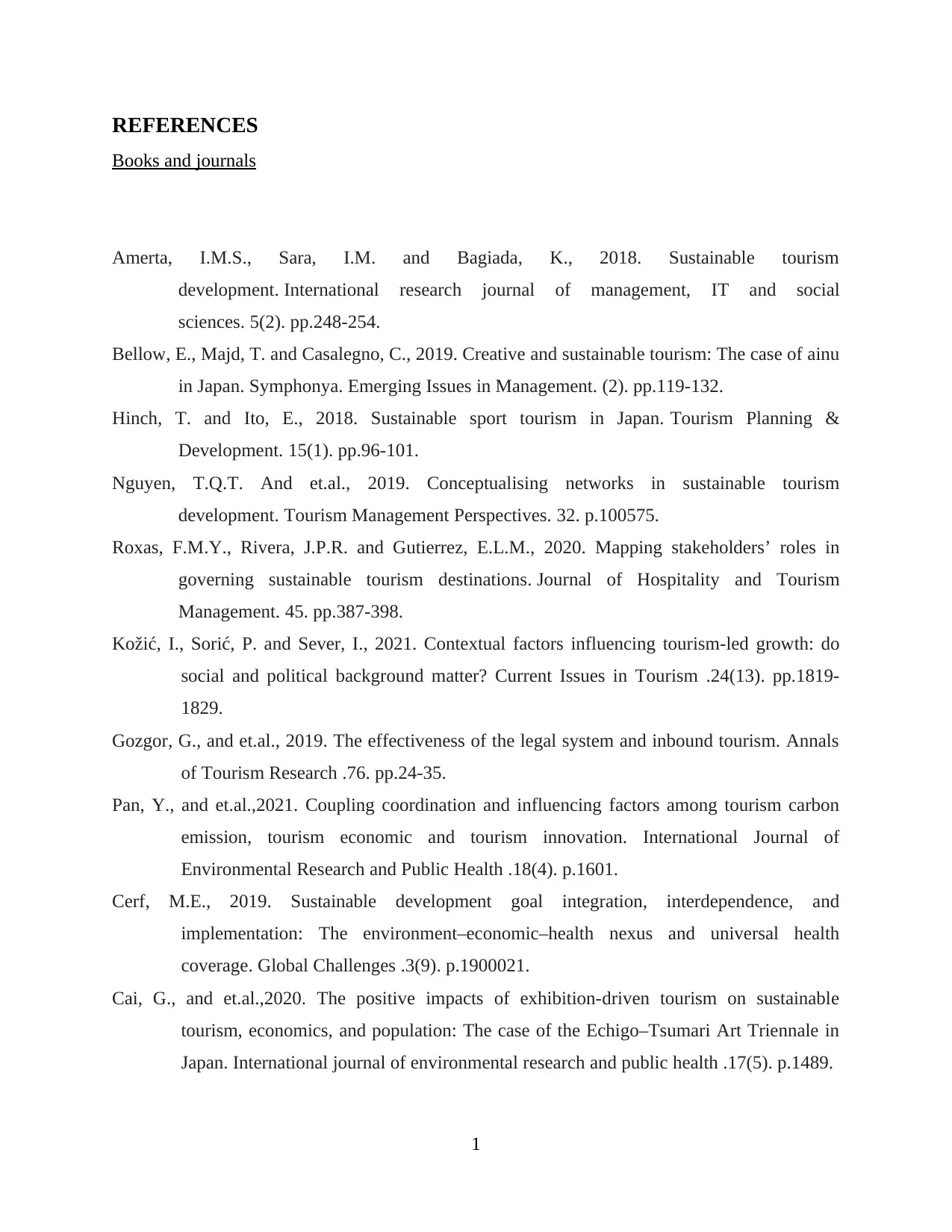
REFERENCES
Books and journals
Amerta, I.M.S., Sara, I.M. and Bagiada, K., 2018. Sustainable tourism
development. International research journal of management, IT and social
sciences. 5(2). pp.248-254.
Bellow, E., Majd, T. and Casalegno, C., 2019. Creative and sustainable tourism: The case of ainu
in Japan. Symphonya. Emerging Issues in Management. (2). pp.119-132.
Hinch, T. and Ito, E., 2018. Sustainable sport tourism in Japan. Tourism Planning &
Development. 15(1). pp.96-101.
Nguyen, T.Q.T. And et.al., 2019. Conceptualising networks in sustainable tourism
development. Tourism Management Perspectives. 32. p.100575.
Roxas, F.M.Y., Rivera, J.P.R. and Gutierrez, E.L.M., 2020. Mapping stakeholders’ roles in
governing sustainable tourism destinations. Journal of Hospitality and Tourism
Management. 45. pp.387-398.
Kožić, I., Sorić, P. and Sever, I., 2021. Contextual factors influencing tourism-led growth: do
social and political background matter? Current Issues in Tourism .24(13). pp.1819-
1829.
Gozgor, G., and et.al., 2019. The effectiveness of the legal system and inbound tourism. Annals
of Tourism Research .76. pp.24-35.
Pan, Y., and et.al.,2021. Coupling coordination and influencing factors among tourism carbon
emission, tourism economic and tourism innovation. International Journal of
Environmental Research and Public Health .18(4). p.1601.
Cerf, M.E., 2019. Sustainable development goal integration, interdependence, and
implementation: The environment–economic–health nexus and universal health
coverage. Global Challenges .3(9). p.1900021.
Cai, G., and et.al.,2020. The positive impacts of exhibition-driven tourism on sustainable
tourism, economics, and population: The case of the Echigo–Tsumari Art Triennale in
Japan. International journal of environmental research and public health .17(5). p.1489.
1
Books and journals
Amerta, I.M.S., Sara, I.M. and Bagiada, K., 2018. Sustainable tourism
development. International research journal of management, IT and social
sciences. 5(2). pp.248-254.
Bellow, E., Majd, T. and Casalegno, C., 2019. Creative and sustainable tourism: The case of ainu
in Japan. Symphonya. Emerging Issues in Management. (2). pp.119-132.
Hinch, T. and Ito, E., 2018. Sustainable sport tourism in Japan. Tourism Planning &
Development. 15(1). pp.96-101.
Nguyen, T.Q.T. And et.al., 2019. Conceptualising networks in sustainable tourism
development. Tourism Management Perspectives. 32. p.100575.
Roxas, F.M.Y., Rivera, J.P.R. and Gutierrez, E.L.M., 2020. Mapping stakeholders’ roles in
governing sustainable tourism destinations. Journal of Hospitality and Tourism
Management. 45. pp.387-398.
Kožić, I., Sorić, P. and Sever, I., 2021. Contextual factors influencing tourism-led growth: do
social and political background matter? Current Issues in Tourism .24(13). pp.1819-
1829.
Gozgor, G., and et.al., 2019. The effectiveness of the legal system and inbound tourism. Annals
of Tourism Research .76. pp.24-35.
Pan, Y., and et.al.,2021. Coupling coordination and influencing factors among tourism carbon
emission, tourism economic and tourism innovation. International Journal of
Environmental Research and Public Health .18(4). p.1601.
Cerf, M.E., 2019. Sustainable development goal integration, interdependence, and
implementation: The environment–economic–health nexus and universal health
coverage. Global Challenges .3(9). p.1900021.
Cai, G., and et.al.,2020. The positive impacts of exhibition-driven tourism on sustainable
tourism, economics, and population: The case of the Echigo–Tsumari Art Triennale in
Japan. International journal of environmental research and public health .17(5). p.1489.
1

2
⊘ This is a preview!⊘
Do you want full access?
Subscribe today to unlock all pages.

Trusted by 1+ million students worldwide
1 out of 9
Related Documents
Your All-in-One AI-Powered Toolkit for Academic Success.
+13062052269
info@desklib.com
Available 24*7 on WhatsApp / Email
![[object Object]](/_next/static/media/star-bottom.7253800d.svg)
Unlock your academic potential
Copyright © 2020–2025 A2Z Services. All Rights Reserved. Developed and managed by ZUCOL.
